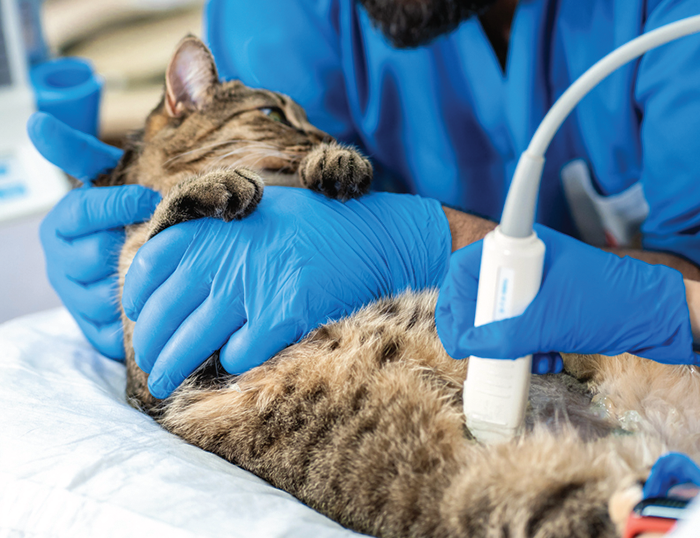What constitutes an emergency? A collapsed cat? Absolutely. And even more so if she is nonresponsive. Pause only a moment to look for a possible cause, but get on the phone to your vet immediately.
Making the decision about whether to head to the emergency veterinary clinic requires you to be quick-thinking. Your cat’s life could be in jeopardy. We consider these scenarios an emergency:
Bleeding wounds: Any open wound, especially if a body cavity is open, means an immediate veterinary visit. It’s worse if the wound is connected to a trauma or a fight. Any cat in an animal fight or bitten by a snake needs care right away. If you suspect the cat has an animal bite, use caution and don’t touch the area or get any saliva or blood on you due to rabies risk. Handle the cat wearing gloves, and keep a blanket around her.
Burns: For optimal healing and pain control, burns need immediate attention. You may see blistered skin, singed hair, white patches, redness, and/or swelling.
Bloody diarrhea: If you see blood in a cat’s diarrhea, contact your veterinarian immediately for specific advice.
Eye problems: If the cat’s eye is painful, red, bulging, or the pupil is dilated, it may be an emergency. Eye problems become serious quickly.
Fracture: A fractured bone must be treated immediately. Keep in mind that not all broken bones are compound, which means you can see bone coming through the skin. A simple fracture still needs to be addressed quickly. If your cat cannot bear weight on a limb, cannot easily move, or cries out when you touch her, a fracture is a possibility.
Heat stroke: Watch for panting, drooling, a red tongue hanging out, lethargy, rapid pulse. Rapid response can make the difference between life and death or permanent damage to organs.
Paralysis: A cat who is suddenly paralyzed in the hind or other limbs may have hypertrophic cardiomyopathy (HCM) or another heart disease and may have experienced a blood clot that can block blood flow to the limbs. HCM can be a silent but deadly health problem, with affected cats going from apparently stable to death’s door quickly.
Respiratory distress: You may notice her struggling to breathe, rapidly panting, or open mouth breathing. Pale or cyanotic (bluish) gums suggest that she is not getting enough oxygen to her tissues, which is an emergency.
Straining in the litterbox: A cat straining to urinate may have a urinary blockage (especially common in male cats). As toxins build in the bloodstream from the urine in the bladder, your cat can go from uncomfortable to very ill very quickly. Straining to defecate is nothing to ignore, but you can often wait overnight to make the call.
Toxin: If your cat may have eaten or been exposed to anything poisonous, call your veterinarian or the Pet Poison Hotline at 800-213-6680.
If you suspect a toxin exposure, bring along a sample of what you think your cat was exposed to if you head to the veterinary clinic.
Trauma: Any time your cat has obvious trauma, she should be seen. Even if outwardly fine, internal injuries could be life-threatening.
Bloody Vomit: If you see blood in vomit, don’t wait.
Seizures/Loss of Consciousness: Any cat with seizures and/or that collapses or loses consciousness should be evaluated by a veterinarian immediately.
Confine your cat in your vehicle. Even if she is collapsed, put her in a carrier because she could panic and escape as soon as you open the door. If you don’t have a carrier, wrap her gently in a large towel or blanket and put a collar and leash on her. Ideally, one person drives while the second person holds the cat and calls to say you’re arriving.
What You Should Know
Know where to go: It’s important to know where the nearest emergency clinic is, and to put that information in an easily accessible spot, like on your refrigerator door. Many clinics only cover emergencies for their own clients, so learn your clinic’s rules now.
Have an emergency fund: Remember, also, that as sad is it seems, a veterinary clinic is a business that needs to generate income to support its operations. You can expect to pay an estimated fee up front, before your cat is admitted to the hospital.
What Problems Can Wait Overnight?
While you need to make the call because you are with the cat, for the most part, if your cat is lame but otherwise fine, which means none of the conditions listed in the main story are observed, she can likely wait overnight. For example:
If your cat is lethargic, this may not be an emergency, but a call to the veterinarian is in order.
If she has an obvious draining abscess, this may not be an emergency, but warrants a veterinary consultation.
If your cat has not eaten for 24 hours, she can usually wait overnight to visit a veterinarian. Don’t delay more than one day to call your veterinarian, however, as cats that don’t eat can get hepatic lipidosis, a serious condition that can be fatal.
If you are in doubt about whether your cat needs to be seen, call the emergency clinic. While they may not be able to fully triage your cat over the phone, they can usually give you an idea of the seriousness of the problem, and whether he needs to be seen immediately.




